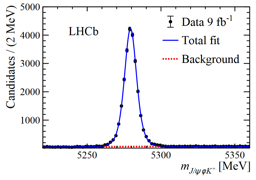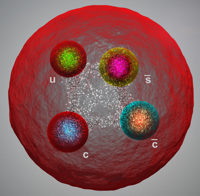Welcome to tetraquark discovery territory
Today, the LHCb Collaboration submitted a paper for publication that reports the first observation of two tetraquarks with a new quark content ccus, decaying to the J/ψ and K+ mesons: a narrow one, Zcs(4000)+, and a broader one Zcs(4220)+. Two other new tetraquarks, X (4685) and X(4630), with a quark content ccss, are also observed. (Here we refer to these exotic hadrons generically as tetraquarks, whereas some experts typically refer to tetraquarks as specific strongly-bound 4-quark states; the exact nature of exotic hadrons is still being debated.)

The four tetraquarks were observed in the decay B+→J/ψφK+ using the full LHCb Run 1 and Run 2 dataset. A practically pure sample of about 24000 candidates was studied as can be seen in the plot to the left, which shows a large peak in the J/ψφK+ invariant-mass spectrum around the B+ mass. The decays were studied with the help of a so-called Dalitz plot, invented in order to study 3-body decays. The axes of the plot are the squares of the invariant masses of two pairs of the decay products. The presence of intermediate particles — formed for a tiny fraction of a second during the B+ particle decay — is revealed through vertical or horizontal bands in what would otherwise be a uniformly-populated plot. The orientation of the band indicates the pair of particles to which the intermediate “resonance” decays. Horizontal bands signal presence of ccus tetraquarks, while vertical bands correspond to the ccss tetraquarks. If the Dalitz plot is interpreted as a tourist map of the tetraquark discovery territory then the North-South mountain ridges represent ccss tetraquarks and West-East ones the ccus tetraquarks.
The study of this decay allows scientists to make exceptional discoveries. Already in June 2016 LHCb has announced observation of four tetraquarks X(4140), X(4274), X(4500) and X(4700) decaying into a J/ψ and a φ meson in the analysis of LHC Run 1 data. The four most apparent vertical bands in the Dalitz plot above further confirm the existence of these ccss tetraquarks in the results presented today.
The possibility of the Zcs+→J/ψK+ contributions in the Run 1 data were also tested. Evidence around 3σ was found, but deemed insufficient to claim for the discovery of an exotic particle with a new quark content. With additional Run 2 data a distinct horizontal band at J/ψK+ invariant mass squared near 16 GeV2 is clearly visible representing the discovery of the Zcs(4000)+ tetraquark in the J/ψK+ decay with a mass of 4003±6+4-14 MeV and a width of 131±15±26 MeV. The image shows the so called Argand diagram proving to experts that the Zcs(4000)+ structure seen in the data (black dots with error bars) really represent resonant particle production and decay, since it follows approximately a circular path (red circle). The Argand plot study is reminiscent of the previous work by LHCb on non-strange tetarquark candidate, Zc(4430)–.
Recently the BESIII experiment reported observation of the structure at the kinematical threshold in the Ds–D*0 + Ds*-D0 mass distribution. When interpreted as a tetraquark, called Zcs(3985)–, its mass is consistent with the Zcs(4000)+ tetraquark reported by LHCb, but its width is ten times smaller. Therefore it is possible that the Zcs(4000)+ and Zcs(3985)– are different particles. Hence we can ask: are there one or two tetraquarks near the Ds–D*0 + Ds*-D0 threshold mass? This question will clearly trigger further intensive experimental and theoretical effort. Various interpretations of the tetraquark binding mechanism have been proposed, including tightly bound tetraquark states and loosely bound meson-meson molecules as discussed often on this web page. An interesting possibility would be that both types are produced, one in e+e– collisions at BESIII and the other one in B meson decays at LHCb, with a similar mass and different widths (indicating different lifetimes). In fact there is a previous evidence from the studies of J/ψπ+ states, that the narrow ccud states, like Zc(3900)+ are produced in e+e– collisions, and broader states like Zc(4430)– are produced in B meson decays, but not vice versa.
In this new LHCb study, a sophisticated “amplitude analysis” approach was used, comparing the data to expectations from various decay hypotheses. This has allowed the discovery of additional exotic states, that are less visible to the naked eye in the plots, and to determine their quantum numbers. In this way a broader Zcs(4220)+ ccus tetraquark was also discovered. Two other new tetraquarks, X (4685) and X(4630), with a quark content ccss are also observed decaying to J/ψφ. The contribution of all the newly discovered exotic particles can be found in the Dalitz plot projections on the J/ψK+ and J/ψφ mass axis below. Note the linear mass scales in the projection plots and the mass square scales in the Dalitz plot.
The tetraquarks that were first discovered had masses close to the masses of charmonium states, hence the question of their classification as tetraquarks or standard charmonium cc neutral particles was open. The Zcs+ particles reported today are charged and therefore are unambiguous exotic candidates since they cannot be included in the charmonium family.
In the conventional quark model, strongly interacting particles, known as hadrons, are formed either from quark-antiquark pairs (mesons) or three quarks (baryons). Particles which cannot be classified within this scheme are referred to as exotic hadrons. In their fundamental 1964 papers [1] and [2], in which they proposed the quark model, Murray Gell-Mann and George Zweig mentioned the possibility of adding a quark-antiquark pair to a minimal meson or baryon quark configuration to form hadrons with four (tetraquark) or five (pentaquark) quark constituents. It took 50 years, however, for physicists to obtain unambiguous experimental evidence of the existence of these exotic hadrons. In April 2014 the LHCb collaboration published measurements that demonstrated that the Z(4430)– particle, first observed by the Belle collaboration, is composed of four quarks (ccdu). Then, a major turning point in exotic baryon spectroscopy was achieved at the Large Hadron Collider in July 2015 when, from an analysis of Run 1 data, the LHCb collaboration reported significant pentaquark structures in the J/ψp mass distribution in Λb0→ J/ψpK– decays. In July 2020 LHCb physicists announced the possible discovery of a four-charm quark tetraquark and in August 2020 the first discovery of an open-charm cdus tetraquark. The image shows an artist’s view of the Zcs+ tetraquark.
More details, including numerical values of new particle properties, can be found in the LHCb publication.
Today’s discovery added four more names to the list of hadrons produced at the LHC. In 11 years of LHC operation 59 hadrons have been discovered by the ATLAS, CMS and LHCb collaborations; on average nearly one every two months. Clearly, the LHC is a Large Hadron Discovery Factory. Read more in the accompanying news and in the CERN Courier article and also in the Conversation article.






